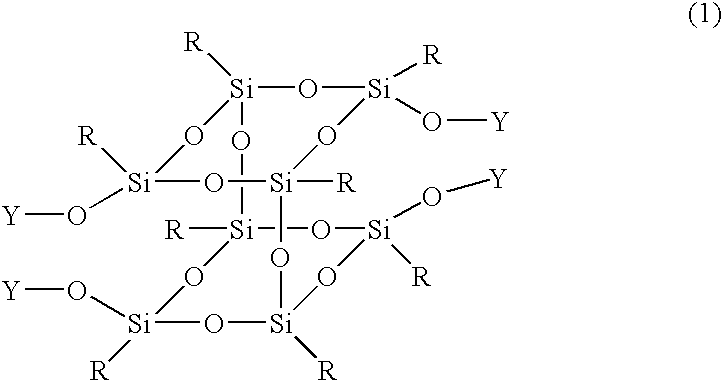Silsesquioxane derivative and process for producing the same
a technology of silsesquioxane and derivatives, which is applied in the field of silsesquioxane derivatives, can solve the problems of incompatibility with general organic polymers, limited number of commercially available ones, and no example of synthesizing psq having a completely or incompletely condensed structure, etc., and achieves the effects of easy production, high yield and convenient production
- Summary
- Abstract
- Description
- Claims
- Application Information
AI Technical Summary
Benefits of technology
Problems solved by technology
Method used
Image
Examples
example 1
[0112] Phenyltrimethoxysilane (6.54 kg), 2-propyl alcohol (26.3 liters), pure water (0.66 kg), and sodium hydroxide (0.88 kg) were put into a 50-liter reactor equipped with a reflux condenser, a thermometer and a stirrer, and sealed up with dry nitrogen. This is heated with stirring, and reacted for 5 hours under reflux. After the reaction, this was left at room temperature for 15 hours, and the supernatant was removed from the resulting reaction mixture through decantation. The resulting residue was led through a pressure filter device equipped with a membrane filter having a pore size of 0.1 μm, and a white solid was separated from it. The white solid was washed once with 2-propyl alcohol (9.87 kg). The substance was transferred into a stainless tray lined with a polytetrafluoroethylene sheet. Using a reduced-pressure drier, this was dried at an inner temperature of 80° C. and under a pressure of 6.7×10−4 MPa for 24 hours, and 2.22 kg of a white powdery solid was thus obtained.
example 2
[0113] The above-mentioned white powdery solid (1.2 g), THF (10 g) and triethylamine (1.6 g) were put into a 50-ml reactor equipped with a dropping funnel, a reflux condenser and a thermometer, and sealed up with dry nitrogen. The solution temperature was kept at 15° C. to 20° C. with stirring with a magnetic stirrer, and chlorotrimethylsilane (2.2 g) was dropwise added to it through the dropping funnel, taking about 1 minute. After the addition, this was continuously stirred at 15° C. for 3.5 hours. Next, deionized water (10 g) was added to it to dissolve the side product, sodium chloride, and the unreacted chlorotrimethylsilane was hydrolyzed. Thus obtained, the reaction mixture was separated into an organic layer and an aqueous layer through a liquid-liquid separation funnel. The resulting organic layer was washed with deionized water, and the washing was repeated until the pH of the wash waste could be neutral. Then, the organic layer was dried with anhydrous magnesium sulfate a...
example 3
[0115] The compound (3-1) obtained in Example 1 (69 g), and toluene (520 g) were put into a 1000-ml reactor equipped with a dropping funnel, a thermometer and a reflux condenser, and sealed up with dry nitrogen. While the solution temperature was kept at 23 to 38° C. with stirring with a magnetic stirrer, chlorodimethylsilane (80 g) was dropwise added to it through the dropping funnel, taking about 11 minutes. After the addition, this was heated in an oil bath with stirring, and reacted at 3 hours under reflux. After the reaction, this was cooled until the reaction solution could be 50° C. or lower. Next, unreacted chlorodimethylsilane was removed through single distillation, and then the reaction solution was concentrated until its amount could be about 1 / 2. This was cooled until the reaction solution could be 50° C. or lower, and then deionized water (150 g) was dropwise added to it through the dropping funnel. After the addition, this was stirred for 10 minutes, and then subjecte...
PUM
| Property | Measurement | Unit |
|---|---|---|
| Magnetic field | aaaaa | aaaaa |
| Mechanical strength | aaaaa | aaaaa |
| Electrical resistance | aaaaa | aaaaa |
Abstract
Description
Claims
Application Information
 Login to View More
Login to View More - R&D
- Intellectual Property
- Life Sciences
- Materials
- Tech Scout
- Unparalleled Data Quality
- Higher Quality Content
- 60% Fewer Hallucinations
Browse by: Latest US Patents, China's latest patents, Technical Efficacy Thesaurus, Application Domain, Technology Topic, Popular Technical Reports.
© 2025 PatSnap. All rights reserved.Legal|Privacy policy|Modern Slavery Act Transparency Statement|Sitemap|About US| Contact US: help@patsnap.com



